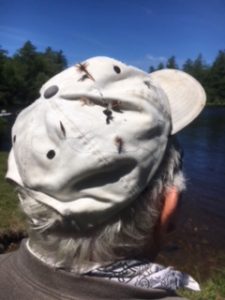The Early Hatches

By Matt LaRoche
The Hendrickson hatch is the first hatch of the season on the river. It usually occurs on or about Memorial Day weekend.
I worked on the West Branch of the Penobscot as Park Manager of the Penobscot River Corridor for over 20-years. During those years, I had the opportunity to fish many evenings on the lower section of the West Branch. Not every evening was a perfect evening of fishing, but when everything came together for a superb night of fishing – that is what makes a lifelong memory!
I came to work on the West Branch from the Allagash Wilderness Waterway and considered myself to be a good fisherman. I found that I could catch plenty of smaller landlocked salmon, but those big fish are very selective and hard to catch.
Lucky for me, a few fishermen took me under their wing and showed me what flies they were using and how to fish those flies. One fisherman, named Stan Peterson explained what the fish were seeing and keyed in on. He talked about duplicating the famous West Branch Caddis and Hendrickson hatches.
Hendrickson Hatch
The Hendrickson hatch is the first hatch of the season on the river. It usually occurs on or about Memorial Day weekend. I can remember fishing off Salmon Point on Nesowdahunk Deadwater on a beautiful calm evening when fish started to rise and I did not have the right fly. That was very frustrating!
I went to talked with Mr. Peterson about the fish rising and not being able to catch any. He explained what the fish were feeding on and that the fish were seeing little tiny sailboat-shaped flies drifting down the river with their wings standing straight up. He also showed me how to tie the Comparadun fly, which simulates the Hendrickson mayfly.
When the salmon are feeding on the Hendrickson, you can see them come up and slowly slurp the flies off the surface of the river. If you are too quick to set the hook, you can actually pull the fly away from a feeding fish. It is very exciting to see a big salmon come up in the same location time after time. As a fisherman, all you need to do is drift the right fly over that feeding fish and wham- that fish will take your fly! That is what keeps us fishing.
At the end of the Hendrickson hatch, you might notice that the fish are coming up to hit your fly, but they are not really taking it- this is called a refusal. When this happens, something has changed, usually the fish have stopped feeding on the flies with their wings straight up and have switched to feeding on the dead version of the Hendrickson, or what we call spent wings. This is the same fly except their wings are spread out flat on the water. If you see this happening, just switch to the spent wing version of the Hendrickson and you’re in business again. This usually happens just before dark and signals an end to the fishing for that night.
Comparadun
The Comparadun is tied with the hair from the forehead of a whitetail deer and stiff tail fibers that help hold the fly straight up. Once I tied a few of these flies, the results were amazing! On the first evening that I fished with my newly tied Comparadun creations, I caught over ten salmon – one over 20 inches long. Even though that was over 25 years ago, I can still remember that evening like it was yesterday.
You can watch a YouTube video showing how to tie the Comparadun at: https://midcurrent.com/videos/tying-a-hendrickson-comparadun/
Matt LaRoche is the owner of Maine Woods Guide Service, a registered Maine Guide, an avid outdoorsman and the retired Superintendent of the Allagash Wilderness Waterway. He can be reached at 207-695-2877 or at matt.laroche2877@gmail.com
For more articles about hunting and fishing, be sure to subscribe to the Northwoods Sporting Journal.
For free access to past issues of the Northwoods Sporting Journal in digital format, click here.
